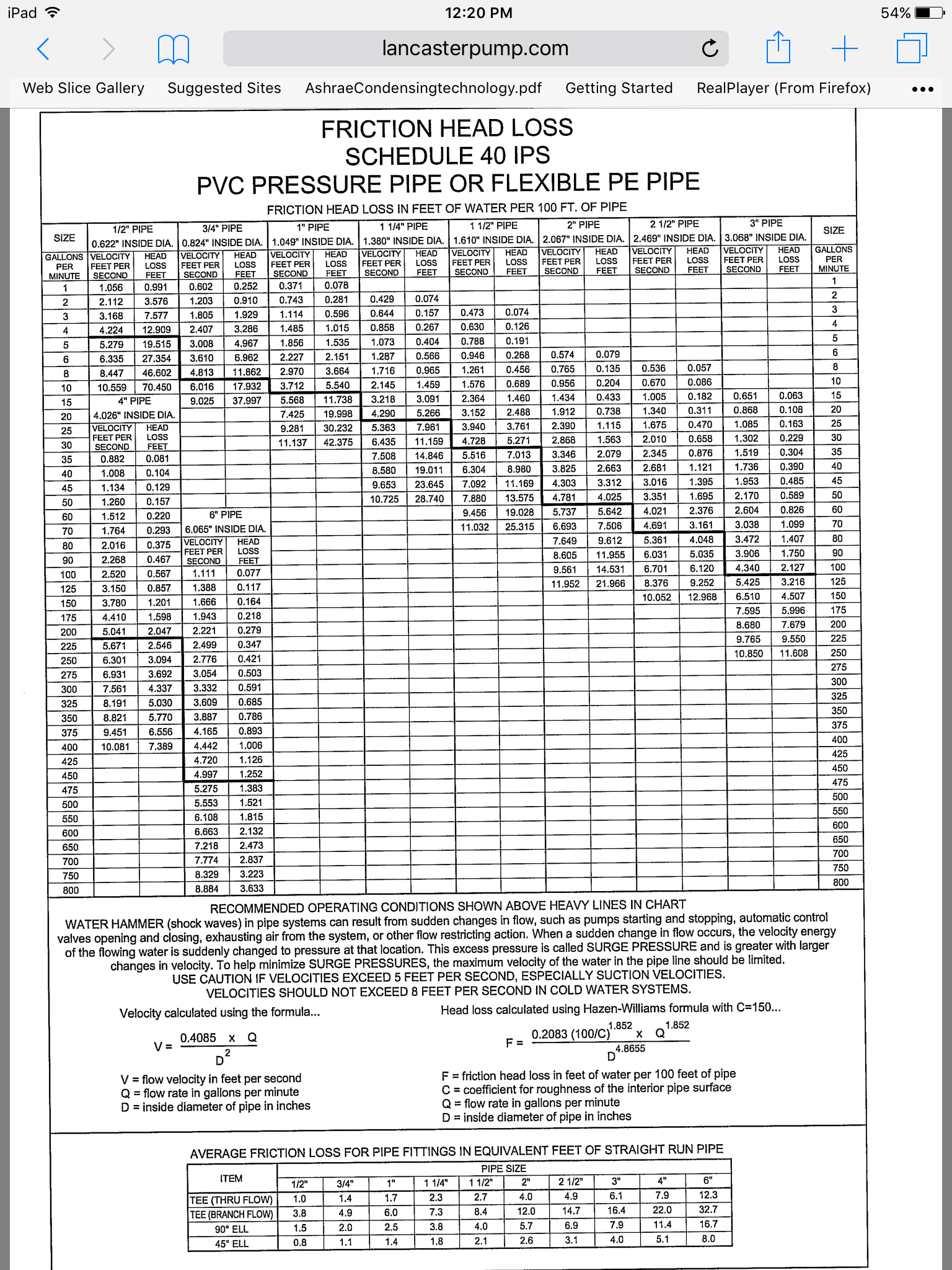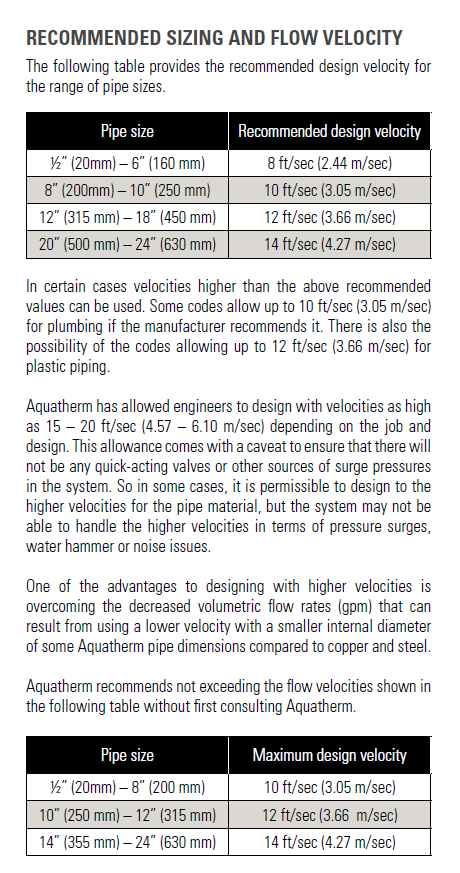Flex PVC

I was called on the troubleshoot a spa that altogether too much of it running at too high a pressure.
It turns out that the pool knuckleheads make the heating knuckleheads look like geniuses.
Thanks in advance..
Albert Einstein
Comments
-
0
-
Is that chart referring to straight length PVC or coiled type well or geo Polyethylene pipe?
I would think that sort of corrugated ID of flexible PVC would present a bit more pressure drop than PVC or smooth walled PE?
I know the corrugated SS solar tube has substantial pressure drop.Bob "hot rod" Rohr
trainer for Caleffi NA
Living the hydronic dream1 -
Thanks Guys,hot rod said:Is that chart referring to straight length PVC or coiled type well or geo Polyethylene pipe?
I would think that sort of corrugated ID of flexible PVC would present a bit more pressure drop than PVC or smooth walled PE?
I know the corrugated SS solar tube has substantial pressure drop.
Hot Rod,
That was my thinking exactly. The pipe is not smooth on the inside it has gentle ripples every 3/8" or so.
I have heard references that indicate a 40% increase in resistance from schedule 40 but nothing concrete.
The pool industry is kind of all over the map with specifications."If you can't explain it simply, you don't understand it well enough"
Albert Einstein0 -
Not a huge difference at 50 gpm. Less than 2' difference in 100'.
How many feet is involved?0 -
Zman said:
Thanks Guys,hot rod said:Is that chart referring to straight length PVC or coiled type well or geo Polyethylene pipe?
I would think that sort of corrugated ID of flexible PVC would present a bit more pressure drop than PVC or smooth walled PE?
I know the corrugated SS solar tube has substantial pressure drop.
Hot Rod,
That was my thinking exactly. The pipe is not smooth on the inside it has gentle ripples every 3/8" or so.
I have heard references that indicate a 40% increase in resistance from schedule 40 but nothing concrete.
The pool industry is kind of all over the map with specifications.
We worked with a Pool Bath and Spa company that jetted all the tubs and spas we put in custom homes. They would only use that flex stuff at the pump connections, for service and removal ease.Zman said:
Thanks Guys,hot rod said:Is that chart referring to straight length PVC or coiled type well or geo Polyethylene pipe?
I would think that sort of corrugated ID of flexible PVC would present a bit more pressure drop than PVC or smooth walled PE?
I know the corrugated SS solar tube has substantial pressure drop.
Hot Rod,
That was my thinking exactly. The pipe is not smooth on the inside it has gentle ripples every 3/8" or so.
I have heard references that indicate a 40% increase in resistance from schedule 40 but nothing concrete.
The pool industry is kind of all over the map with specifications.
They would heat and bend PVC with one of those roller machine that electricians use to bend PVC conduit if they were doing a round or octagon tubs.
I'm not sure if it was pressure drop, cost, or the glue fittings not holding as well, maybe that it just looked sloppy, but they sure avoided that flex PVC.
Bob "hot rod" Rohr
trainer for Caleffi NA
Living the hydronic dream0 -
I would think with the expansion cycles, and spa temps you would want to avoid as many glued connections as possible. At least in a stand alone unit.0
-
I was told by a pool / spa guy that flex pvc was found to be susceptible to termite damage , and that was the reason that it is not used as much as it was five years ago. Sounds ridicules to me but he believed what he was saying. I have a few feet of it at my pool pump and have not noticed any termites messing with it , lol.hvacfreak
Mechanical Enthusiast
Burnham MST 396 , 60 oz gauge , Tigerloop , Firomatic Check Valve , Mcdonnell Miller 67 lwco , Danfoss RA2k TRV'sEasyio FG20 Controller
1 -
True or not, it appears to be widely believed http://www.riverpoolsandspas.com/blog/bid/28778/Swimming-Pool-Plumbing-Rigid-PVC-vs-Flexible-PVC-Which-is-Better0
-
These tubs have over 50 feet of 2" flex each way. The pipes are failing at a rapid rate.
They are contemplating replacing it with the same because they can snake it though a sleeve under a slab.
I am wanting to document the existing setup and show them how much energy they would save and how much more efficient the system would be if they tore up the concrete and put in properly sized hard pipe, with properly sized pumps. Right now they need a 3 hp jet pump. Around 90 gpm and 90 feet of head...
Would the ideal pipe be schedule 80 pvc spray foamed in a trench?"If you can't explain it simply, you don't understand it well enough"
Albert Einstein0 -
90 GPM in 2" PVC! There's your problem, Vern.
That must be near 9fps, screaming fast. I think 3" would be a better choice? Or two runs of 2"?
This table show choices at 4 fps.
Larger than 2" the pipe get sized a bit differently, based on head loss per 100'
This is from Idronics 16 Bob "hot rod" Rohr
Bob "hot rod" Rohr
trainer for Caleffi NA
Living the hydronic dream1 -
Funny with Kurts chart that would seem to be at the upper end of an exceptable flow rate for 2" flex pvc.
However I like the notes at the bottom of my chart which touches on pump surge, etc.
That will tear some stuff up with a spa.
How old is the present system?0 -
The pool & spa industry often tends to treat friction losses as a pump sizing issue.0
-
True Kurt. A hatchery scenario which your chart seems to cover is far more different than a spa.
Water temps, on/off cycles etc.
0 -
Hot Rod,
Yah Vern, looks like the water is moving pretty fast. I quick calc says 2.5" supply and 3" return would be about right. I am surprised it is not cavitating. The inlet pressure is surely sub atmospheric. The pump being 14' below the tub helps.
We will need to leave some of the 2" flex on the tubs and knowing how to calc it would help. It is going to look a bit funny going for 2" to 3" and back again but so be it. The tubs will be replaced in about 2 years so we are trying to plan for that.
I think the newly purchased 3 hp pumps will need a freq drive or perhaps replacement after the piping is updated.
Gordy,
The tubing is dated 2011. It is bulging and failing at the spirals.
SWEI,
The spa industry is way behind the times. Finding any meaningful specs on anything but circulators is difficult. The attached manual is very helpful.
Does anyone have opinions on schedule 40 vs 80 or PVC vs CPVC? Other options?"If you can't explain it simply, you don't understand it well enough"
Albert Einstein0 -
-
Carl keep in mind the filtration gpm needs, and turn over of the spa volume.
0 -
-
I was just looking at the Pentair Intelliflow. You would be a hero Carl once the utilities rolled in.0
-
Yes,
I am going to look at all that once the pipes are correct. It is a bummer they just bought new ones.
The filters are separate from the jet pumps so they can be evaluated on there own.
I got away with not looking at the disaster spa setup for about 6 months. Then one day they asked....
It should be an interesting one!"If you can't explain it simply, you don't understand it well enough"
Albert Einstein0 -
Wow those are crazy high velocities they list.
Here is a sample of a sizer from the Aquatherm site. I think they recommend staying below 5 fps in their plastics.
Bob "hot rod" Rohr
trainer for Caleffi NA
Living the hydronic dream0 -
-
I would think the sole act of turning the pumps on can wreak havoc on pvc pipe, and fittings. Couple that with spa temperatures.0
-
I think that 4- 5 fps in hydronics has a lot to do with noise and air removal. It gets harder to scrub micro bubbles out at those high flow rates. In metallic pipe 5 fps is where it starts to be heard.
3.4 mph doesn't sound fast but trying to watch that velocity in my clear pipe demo..
So fast it will make your head spin.
d trumfBob "hot rod" Rohr
trainer for Caleffi NA
Living the hydronic dream0 -
I am actually psyched about this one. I think you size for 4 ft/sec and over sized the returns a bit to avoid cavitation. That will future proof it a bit. I think I would be comfortable with 6 ft/sec max if they upgrade the tubs."If you can't explain it simply, you don't understand it well enough"
Albert Einstein1 -
3"If you can't explain it simply, you don't understand it well enough"
Albert Einstein0
Categories
- All Categories
- 87.3K THE MAIN WALL
- 3.2K A-C, Heat Pumps & Refrigeration
- 61 Biomass
- 429 Carbon Monoxide Awareness
- 120 Chimneys & Flues
- 2.1K Domestic Hot Water
- 5.8K Gas Heating
- 115 Geothermal
- 166 Indoor-Air Quality
- 3.7K Oil Heating
- 77 Pipe Deterioration
- 1K Plumbing
- 6.5K Radiant Heating
- 395 Solar
- 15.7K Strictly Steam
- 3.4K Thermostats and Controls
- 56 Water Quality
- 51 Industry Classes
- 50 Job Opportunities
- 18 Recall Announcements





